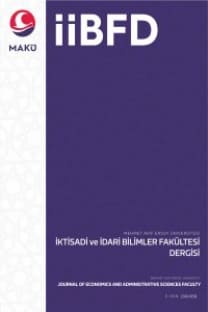KÜRESEL HURDA DEMİR TİCARETİ İLİŞKİLERİNİN SOSYAL AĞ ANALİZİ YÖNTEMİYLE DEĞERLENDİRİLMESİ
Sosyal Ağ Analizi, Hurda Demir, Uluslararası Ticaret
ASSESSMENT OF GLOBAL SCRAP IRON TRADE RELATIONS USING SOCIAL NETWORK ANALYSIS METHOD
Social Network Analysis, Scrap Iron, International Trade,
___
- BMUV, (2023). Waste Policy, 24.01.2023 tarihinde https://www.bmuv.de/en/topics/water-resources-waste/circular-economy/waste-policy adresinden alındı.
- Bureau of International Recycling. (2020). (rap.). World steel recycling in figures 2016 – 2020. Bir Global Facts & Figures. 16.11.2021 tarihinde https://www.bir.org/publications/facts-figures/download/821/175/36?method=view adresinden alındı.
- Çelik, Ş. (2021). Sosyal ağ anali̇zi̇ ve bir uygulaması. Journal of Original Studies, 2(1), 29–41. https://doi.org/10.47243/jos.2.1.04
- Davis, J., Geyer, R., Ley, J., He, J., Clift, R., Kwan, A., ... ve Jackson, T. (2007). Time-dependent material flow analysis of iron and steel in the UK: Part 2. Scrap generation and recycling. Resources, conservation and recycling, 51(1), 118-140.
- Dworak, S., ve Fellner, J. (2021). Steel scrap generation in the EU-28 since 1946–Sources and composition. Resources, Conservation and Recycling, 173, 105692.
- Earth 911. (2021). How to recycle scrap metal. 24.12.2021 tarihinde https://earth911.com/recycling-guide/how-to-recycle-metal/ adresinden alındı.
- Erkekoğlu, H., ve Yılmaz, B. (2020). OECD ülkeleri̇ni̇n grup içi ti̇cari̇ i̇li̇şki̇leri̇ni̇n ağ anali̇zi̇ i̇le değerlendirilmesi. Erciyes Üniversitesi İktisadi ve İdari Bilimler Fakültesi Dergisi, (19. Uluslararası İşletmecilik Kongresi Özel Sayısı), 321–344. https://doi.org/10.18070/erciyesiibd.846530
- Estrada, E. (2015). Introduction to complex networks: Structure and Dynamics. In J. Banasiak ve M. Mokhtar-Kharroubi (Eds.), Evolutionary equations with applications in Natural Sciences (C. 2126, ss. 99–131). essay, Springer, Cham, https://doi.org/10.1007/978-3-319-11322-7_3.
- Fenton, M. D. (2002). Minerals yearbook, volume I, metals and minerals. Minerals Yearbook. 18.11.2021 tarihinde https://pubs.er.usgs.gov/publication/70048194 adresinden alındı.
- Gürsakal, N. (2009). Sosyal ağ analizi: Pajek Ucinet ve Gmine uygulamalı. Dora Yayınları.
- IEEFA. (2021). New From Old: The Global Potential for More Scrap Steel Recycling. 30.01.2023 tarihinde https://ieefa.org/sites/default/files/resources/The-Global-Potential-for-More-Scrap-Steel-Recycling-December-2021-2.pdf adresinden alındı.
- Ma, Y., Wang, M., ve Li, X. (2022). Analysis of the characteristics and stability of the global complex nickel ore trade network. Resources Policy, 79, 103089.
- Medaglia, J. D. ve Bassett, D. S. (2017). Network analyses and nervous system disorders, United Kingdom: Oxford University Press.
- Ohimain, E. I. (2013). Scrap iron and steel recycling in Nigeria. Greener Journal of Environmental management and public safety, 2(1), 1-9.
- Pacini, H., Shi, G., Sanches-Pereira, A., ve da Silva Filho, A. C. (2021). Network analysis of international trade in plastic scrap. Sustainable Production and Consumption, 27, 203-216.
- Ruhnau, B. (2000). Eigenvector-centrality—a node-centrality?. Social networks, 22(4), 357-365.
- Sawyer, J. W. (2017). Automotive scrap recycling: Processes, prices, and prospects. Routledge.
- Spoerl, J. S. (2004). A brief history of iron and steel production. The Industrial Revolution in England. 10.11.2021 tarihinde https://web.archive.org/web/20160421065413/http://www.anselm.edu/homepage/dbanach/h-carnegie-steel.htm adresinden alındı.
- Yavuzaslan, K. ve Soyyiğit, S. (2019). Türkiye ve Rusya Arasındaki Ticari İlişkilerin Kompleks Ağ Yaklaşımı ile Sektör Bazlı Analizi. Iğdır Üniversitesi Sosyal Bilimler Dergisi, (18), 401-433. https://dergipark.org.tr/tr/pub/igdirsosbilder/issue/66824/1045210 adresinden alındı.
- Terao, T. (2013). From shipbreaking to ship recycling: relocation of recycling sites and the expansion of international involvement. International Trade in Recyclable and Hazardous Waste in Asia. Edward Elgar Publishing.
- Toroczkai, Z. (2005). Complex networks the challenge of interaction topology. Los Alamos Science, 29, 94–109. 10.10.2021 tarihinde https://permalink.lanl.gov/object/tr?what=info:lanl-repo/lareport/LA-UR-04-7345 adresinden alındı.
- Tunalı, V. (2016). Sosyal ağ analizine giriş. Ankara: Nobel Yayıncılık.
- UN Comtrade Database. (2020). 17.12.2021 tarihinde https://comtradeplus.un.org/TradeFlow?Frequency=A&Flows=X&CommodityCodes=TOTAL&Partners=0&Reporters=all&period=2021&AggregateBy=none&BreakdownMode=plus. adresinden alındı.
- Us Epa. (2021). Environmental Factoids. 23.12.2021 tarihinde https://archive.epa.gov/epawaste/conserve/smm/wastewise/web/html/factoid.html adresinden alındı.
- Wang, C., Huang, X., Lim, M. K., Tseng, M. L., & Ghadimi, P. (2020). Mapping the structural evolution in the global scrap copper trade network. Journal of Cleaner Production, 275, 122934.
- Wübbeke, J., ve Heroth, T. (2014). Challenges and political solutions for steel recycling in China. Resources, Conservation and Recycling, 87, 1–7. https://doi.org/10.1016/j.resconrec.2014.03.004
- World Steel Association. (2018). Steel Facts. 23.12.2021 tarihinde https://worldsteel.org/wp-content/uploads/Steel-Statistical-Yearbook-2018.pdf
- World Steel Association. (2020). Steel Statistical Yearbook 2020. 16.12.2021 tarihinde https://worldsteel.org/steel-by-topic/statistics/annual-production-steel-data/ adresinden alındı
- ISSN: 2149-1658
- Yayın Aralığı: Yılda 3 Sayı
- Yayıncı: Mehmet Akif Ersoy Üniversitesi İktisadi ve İdari Bilimler Fakültesi
İsmail Fatih CEYHAN, Merve KARA
FÜTÜRİSTİK BİR KAMUSAL ALAN ALTERNATİFİ OLARAK METAVERSE
BUCAK İLÇESİ HAKKINDA YAPILAN AKADEMİK ÇALIŞMALARA YÖNELİK İÇERİK ANALİZİ
İsmail BEKCİ, Ali APALI, Şule ŞAHİN
AŞILAMANIN COVID-19 ÖLÜMLERİNE ETKİSİ: ÜLKELERİN GELİR GRUPLARINA GÖRE BİR ARAŞTIRMA
Osman ŞENOL, Ümit ÇIRAKLI, Durmuş GÖKKAYA
Sumeyra SARIDAĞ, Hamza Bahadır ESER
KÜRESEL HURDA DEMİR TİCARETİ İLİŞKİLERİNİN SOSYAL AĞ ANALİZİ YÖNTEMİYLE DEĞERLENDİRİLMESİ
İSTANBUL SÖZLEŞMESİNİN ANALİZİ VE KADINA YÖNELİK ŞİDDETİN ÖNLENMESİ İÇİN POLİTİKA İLKELERİ ÖNERİSİ
KOBİ`LERDE STRATEJİK PAZARLAMA YÖNETİMİ: LÜLEBURGAZ ÖRNEĞİ
Onur ŞAYLAN, Yusuf ESMER, Pelin ÇELİK
YEŞİL İŞLER ÜZERİNE YAPILAN ÇALIŞMALARIN BİBLİYOMETRİK ANALİZ YÖNTEMİ İLE İNCELENMESİ
Şerife DURMAZ, Aydın ÇİVİLİDAĞ, Murşit IŞIK
UMUDUN YAŞAM DOYUMU VE OLUMLU GELECEK BEKLENTİSİ ÜZERİNE ETKİSİ
